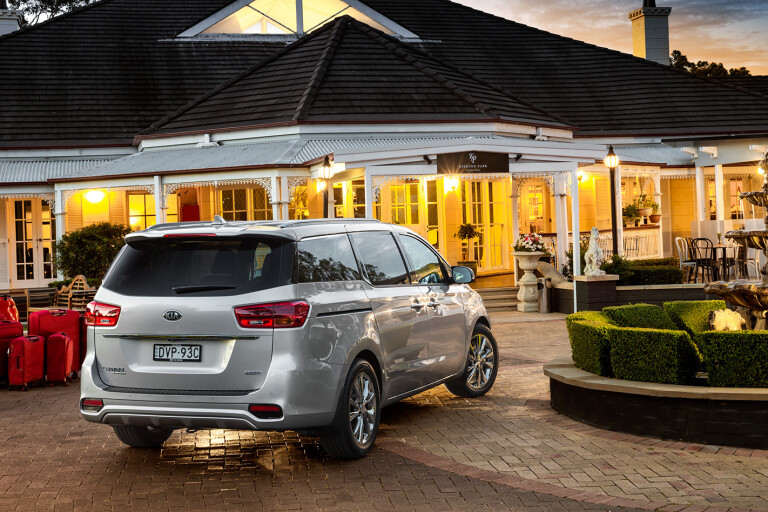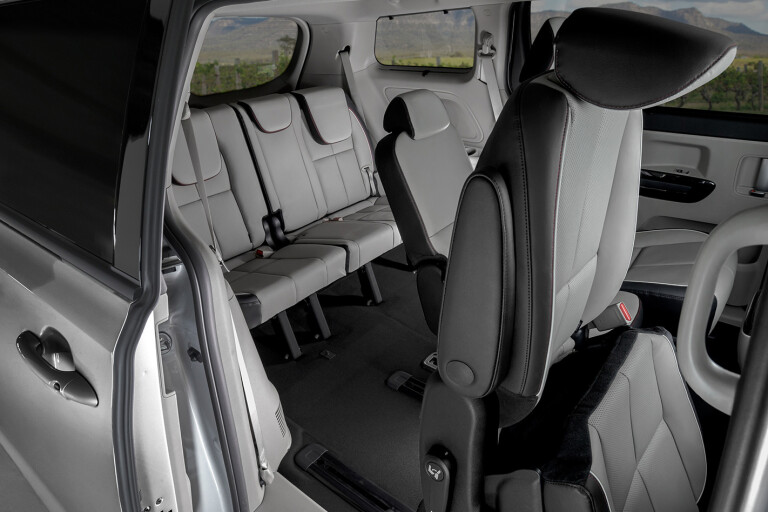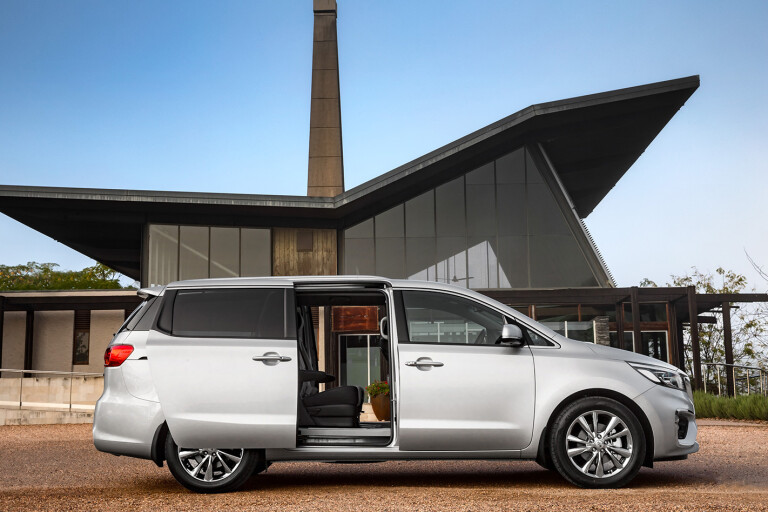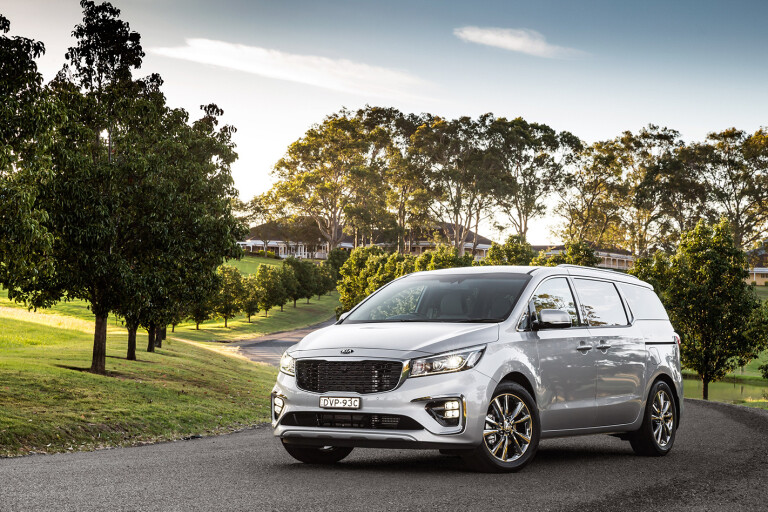.jpg )
At $62,790, the Kia Carnival is the most expensive car you can buy in the Korean car maker’s Australian line-up and reaches well into luxury car territory.
TELL ME ABOUT THIS CAR

The diesel-engined Platinum sits right at the top of the Carnival people mover’s eight-variant line-up. It’s something of a halo model for the Australian Open sponsor; visit Melbourne in summer and you’ll see a fleet of these, featuring all the bells and whistles, shuffling players to and from the tennis centre.
In its earlier days, the Carnival was a bit dire, beset with hard-wearing, heavily plastic interiors with little visual or textural delight, thrummy and thirsty petrol engines and drive-’em-till-they-break ownership circle.
But this latest version of the Carnival is a new breed of breeder bus, updated earlier this year with a slick, new eight-speed automatic transmission as part of a midlife makeover, revised suspension and even higher levels of city-smart safety. And it’s all under the umbrella of a seven-year warranty.

STRENGTHS
- It’s very well equipped for a Kia. Both sliding side doors and bootlid open electrically, either with the tug of a door handle or via a press of the button on the key fob. Once everyone’s inside, the driver can close everything via roof console-mounted buttons.
- It’s comfortable. The big, wide leather-trimmed seats in the first two rows, and even the smaller ones in the third row, fold flat into the boot floor are all comfy and supportive, and tuned for long distances. Outboard second-row seats are captain’s chairs with fold-down armrests.
- It can seat six adults in comfort, eight at a pinch. The narrow and firm second-row middle seat, which needs its seatbelt to drop down from the roof, serves better with the backrest flipped forward, revealing a storage tray and a couple of extra cupholders to complement the two on the back of the centre console. The rearmost bench split-folds 60:40
- That warranty. Keep the Carnival for four years as the kids grow up into it and, by the time you go to on-sell it, you’ll still have three years of warranty left to lure in a buyer.
- It’s comfy in the front row. The range-topping Carnival has swathes of leather and pleasant plastics (although the black wood trim on the steering wheel is an ugly contrast to the two-tone brown and beige trim on the dash) including heated and cooled front seats, a heated steering wheel, and a surround-view camera that helps with parking.
- The sliding rear doors are good in a car park. It’s a better alternative to large SUVs that use swinging rear doors that need plenty of room to accommodate less-than-attentive children who don’t think twice about dinging the doors of the car you’ve parked next to. The Carnival’s sliding doors open a huge aperture yet leave plenty of room to squeeze past.
- The second-row seats cleverly squash up on both sides to provide heaps of room to squeeze past into the third row. They can slide forward to yield even more room, and will return to the same place they were in before tumbling forward. Not all people movers do that. Some also only tumble forward on the passenger side.
- It now has an electric parking brake with a hill-hold function that stops it rolling back downhill. The previous foot-operated parking brake was a cheap and cumbersome solution. Now that it has gone, it won’t be missed.

- It’s very safe. Active cruise control that will even bring the big van to a complete stop on the freeway complements a five-star crash rating.
- The diesel engine is now much quieter. The 2.2-litre four-cylinder engine was a bit gruff, growly and whistling in the model this replaces, but it is now much quieter and smoother. It’s economical, too, given that effectively this is a big box that has to push a lot of air out of the way on a freeway run.
- It drives a lot better. The Carnival has dropped its old six-speed auto in exchange for the new eight-speeder fitted to the Kia Stinger sports sedan. It pairs well with the diesel engine, providing fast, smooth changes. Revisions to the suspension have really lifted the Carnival’s game with just a few people on board – we’re yet to experience it with a full book.
- It still has a useable boot, even with the third-row seats up. The space, though, is very deep. Drop the rearmost seats, and you have a surprising amount of real estate to fill.
- The rear seats gain their own climate control settings. Heating and cooling is vented to both back rows via roof-mounted vents.
WEAKNESSES
- The electrically assisted steering is still too highly assisted and overly feel-free. This probably won’t trouble too many buyers, because ease of manoeuvrability is key for such a wide, long vehicle, but you’re never exactly sure what the front wheels are doing.
- The engine doesn’t have a stop-start function. Instead, the range-topping Carnival has an “activeECO” button that makes the throttle doughy and less responsive, and encourages the transmission to chase higher gears. Leaving it in the default mode feels right.
- We’ve criticised the Carnival for having a ride that’s a little too bouncy in the third row of seats. That may have something to do in the fact that the fold-up seats are a lot thinner and firmer to sit on than the more plush seats for other two rows, which isn’t helped by being located above the rear axle.
- There’s only a single USB slot available to the rearmost five seats. Switched-on and power-hungry Gen Zedders will fight to the death over it.

ARE THERE ANY RIVALS I SHOULD CONSIDER?
The Hyundai iMax is basically a moving van with seats, and is a cheap, albeit less safe in the event of a crash, alternative to the Carnival. Other choices include the considerably more expensive Mercedes-Benz V-Class, the Volkswagen Multivan, the petrol-only (and quite thirsty) Toyota Tarago Ultima V6, Honda Odyssey and the very cheap and unproven nine-seat LDV G10, which uses a surprisingly small turbocharged 2.0-litre petrol engine to haul itself along the road.

COMMENTS